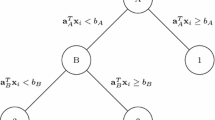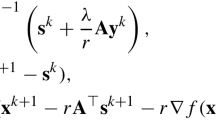Abstract
The simplex method, created by George Dantzig, optimally solves a linear program by pivoting. Dantzig’s pivots move from a basic feasible solution to a different basic feasible solution by exchanging exactly one basic variable with a nonbasic variable. This paper introduces the double pivot simplex method, which can transition between basic feasible solutions using two variables instead of one. Double pivots are performed by identifying the optimal basis in a two variable linear program using a new method called the slope algorithm. The slope algorithm is fast and allows an iteration of DPSM to have the same theoretical running time as an iteration of the simplex method. Computational experiments demonstrate that DPSM decreases the average number of pivots by approximately 41% on a small set of benchmark instances.




Similar content being viewed by others
References
Alterovitz R, Lessard E, Pouliot J, Hsu I, O’Brien J, Goldberg K (2006) Optimization of HDR brachytherapy dose distributions using linear programming with penalty costs. Med Phys 33(11):4012–4019
Appelgren L (1969) A column generation algorithm for a ship scheduling problem. Transp Sci 3(1):53–68
Bartels R (1971) A stabilization of the simplex method. Numer Math 16(5):414–434
Bartolini F, Bazzani G, Gallerani V, Raggi M, Viaggi D (2007) The impact of water and agriculture policy scenarios on irrigated farming systems in Italy: an analysis based on farm level multi-attribute linear programming models. Agric Syst 93(1):90–114
Bazaraa M, Jarvis J, Sherali H (2009) Linear programming and network flows. Wiley, New Jersey
Bertsimas D, Tsitsiklis J (1997) Introduction to linear optimization. Athena Scientific, Belmont
Bland R (1977) New finite pivoting rules for the simplex method. Math Oper Res 2(2):103–107
Chalermkraivuth K, Bollapragada S, Clark M, Deaton J, Kiaer L, Murdzek J, Neeves W, Scholz B, Toledano D (2005) GE asset management, Genworth financial, and GE insurance use a sequential-linear-programming algorithm to optimize portfolios. Interfaces 35(5):370–380
Coppersmith D, Winograd S (1990) Matrix multiplication via arithmetic progressions. J Symb Comput 9(3):251–280
Dantzig G (1947) Maximization of a linear function of variables subject to linear inequalities. In: Koopmans TC (ed) Activity analysis of production and allocation, 1951. Wiley, New York, pp 339–347
Dantzig G (1982) Reminiscences about the origins of linear programming. Oper Res Lett 1(2):43–48
Dantzig G, Orchard-Hays W (1954) The product form for the inverse in the simplex method. Math Tables Aids Comput 8(46):64–67
Dantzig G, Wolfe P (1960) Decomposition principle for linear programs. Oper Res 8(1):101–111
Dongarra J, Sullivan F (2000) Guest editors’ introduction: the top 10 algorithms. Comput Sci Eng 2(1):22–23
Dorfman R (1984) The discovery of linear programming. Ann Hist Comput 6(3):283–295
Dyer M (1984) Linear time algorithms for two- and three-variable linear programs. SIAM J Comput 13(1):31–45
Edmonds J (1967) Systems of distinct representatives and linear algebra. J Res Natl Bur Stand 71B(4):241–245
Eldersveld S, Saunders M (1992) A Block-LU update for large-scale linear programming. SIAM J Matrix Anal A 13(1):191–201
Elhallaoui I, Metrane A, Desaulniers G, Soumis F (2010) An improved primal simplex algorithm for degenerate linear programs. INFORMS J Comput 23(4):569–577
Ford L, Fulkerson D (1958) A suggested computation for maximal multi-commodity network flows. Manage Sci 5(1):97–101
Forrest J, Tomlin J (1972) Updated triangular factors of the basis to maintain sparsity in the product form simplex method. Math Program 2(1):263–278
García J, Florez J, Torralba A, Borrajo D, López C, García-Olaya Á, Sáenz J (2013) Combining linear programming and automated planning to solve intermodal transportation problems. Eur J Oper Res 227(1):216–226
Gass S, Vinjamuri S (2004) Cycling in linear programming problems. Comput Oper Res 31(2):303–311
Gautier A, Lamond B, Paré D, Rouleau F (2000) The québec ministry of natural resources uses linear programming to understand the wood-fiber market. Interfaces 30(6):32–48
Gay D (1985) Electronic mail distribution of linear programming test problems. Math Program Soc COAL Newslett 13:10–12
Gilmore P, Gomory R (1961) A linear programming approach to the cutting-stock problem. Oper Res 9(6):849–859
Gilmore P, Gomory R (1963) A linear programming approach to the cutting-stock problem—part II. Oper Res 11(6):863–888
Goldfarb D, Todd M (1989) Linear programming. In: Nemhauser GL, Rinnooy Kan AHG, Todd MJ (eds) Handbooks in operations research and management science, vol 1. North-Holland, Amsterdam, pp 73–170
Gomes A, Oliveira J (2006) Solving irregular strip packing problems by hybridising simulated annealing and linear programming. Eur J Oper Res 171(3):811–829
Gondzio J (2012) Interior point methods 25 years later. Eur J Oper Res 218(3):587–601
He J (1999) Homotopy perturbation technique. Comput Methods Appl Mech Eng 178(3–4):257–262
Hillier F, Lieberman G (2015) Introduction to operations research. McGraw-Hill, New York
Howard R (1960) Dynamic programming and Markov processes. The MIT Press, Cambridge
Huangfu Q, Julian Hall J (2015) Novel update techniques for the revised simplex method. Comput Optim Appl 60(3):587–608
Illés T, Terlaky T (2002) Pivot versus interior point methods: pros and cons. Eur J Oper Res 140(2):170–190
Kantorovich L (1939) Mathematical methods of organizing and planning production. Manage Sci 6(4):366–422 (1939 Russian, 1960 English)
Karmarkar N (1984) A new polynomial-time algorithm for linear programming. Combinatorica 4(4):373–395
Khachiyan L (1979) A polynomial algorithm in linear programming. Sov Math Dokl 20(1):191–194
Klee V, Minty G (1972) How good is the simplex algorithm? In: Shisha O (ed) Inequalities-III: proceedings of the third symposium on inequalities. Academic Press, New York, pp 159–175
Koch T, Achterberg T, Andersen E, Bastert O, Berthold T, Bixby R, Danna E, Gamrath G, Gleixner A, Heinz S, Lodi A, Mittelmann H, Ralphs T, Salvagnin D, Steffy D, Wolter K (2011) MIPLIB 2010. Math Program Comput 3(2):103–163
Kojima M, Mizuno S, Yoshise A (1989) A primaldual interior point algorithm for linear programming. In: Megiddo N (ed) Progress in mathematical programming: interior-point algorithms and related methods. Springer, New York, pp 29–47
Kojima M, Megiddo N, Mizuno S (1993) A primal-dual infeasible-interior-point algorithm for linear programming. Math Program 61(1):263–280
Koopmans T (1949) Optimum utilization of the transportation system. Econometrica 17(Supplement):136–146
Kunnumkal S, Talluri K, Topaloglu H (2012) A randomized linear programming method for network revenue management with product-specific no-shows. Transport Sci 46(1):90–108
Lee E, Gallagher R, Patterson D (2003) A linear programming approach to discriminant analysis with a reserved-judgment region. INFORMS J Comput 15(1):23–41
Lustig IJ, Marsten RE, Shanno DF (1994) Interior point methods for linear programming: computational state of the art. ORSA J Comput 6(1):1–14
Mansini R, Ogryczak W, Speranza M (2007) Conditional value at risk and related linear programming models for portfolio optimization. Ann Oper Res 152(1):227–256
Megiddo N (1983) Linear-time algorithms for linear programming in \(\mathbb{R}^{3}\) and related problems. SIAM J Comput 12(4):759–776
Megiddo N (1989) Pathways to the optimal set in linear programming. In: Megiddo N (ed) Progress in mathematical programming: interior-point algorithms and related methods. Springer, New York, pp 131–158
Mehrotra S (1992) On the implementation of a primal-dual interior point method. SIAM J Optim 2(4):575–601
Nadarajah S, Margot F, Secomandi N (2015) Relaxations of approximate linear programs for the real option management of commodity storage. Manage Sci 61(12):3054–3076
Padberg M (1999) Linear optimization and extensions. Algorithms and combinatorics, vol 12. Springer-Verlag
Press W, Teukolsky S, Vetterling W, Flannery B (2007) Numerical recipes. Cambridge University Press, New York
Raymond V, Soumis F, Orban D (2010) A new version of the improved primal simplex for degenerate linear programs. Comput Oper Res 37(1):91–98
Reid J (1982) A sparsity-exploiting variant of the Bartels–Golub decomposition for linear programming bases. Math Program 24(1):55–69
Romeijn H, Ahuja R, Dempsey J, Kumar A (2006) A new linear programming approach to radiation therapy treatment planning problems. Oper Res 54(2):201–216
Rong A, Lahdelma R (2008) Fuzzy chance constrained linear programming model for optimizing the scrap charge in steel production. Eur J Oper Res 186(3):953–964
Schrijver A (1998) Theory of linear and integer programming. Wiley, New York
Shamos M, Hoey D (1976) Geometric intersection problems. In: Seventeenth annual IEEE symposium on foundations of computer science, pp 208–215
Spielman D, Teng S (2004) Smoothed analysis of algorithms: why the simplex algorithm usually takes polynomial time. J ACM 51(3):385–463
Spitter J, Hurkens C, de Kok A, Lenstra J, Negenman E (2005) Linear programming models with planned lead times for supply chain operations planning. Eur J Oper Res 163(3):706–720
Strassen V (1969) Gaussian elimination is not optimal. Numer Math 13(4):354–356
Suhl L, Suhl U (1993) A fast LU update for linear programming. Ann Oper Res 43(1):33–47
Suhl U, Suhl L (1990) Computing sparse LU factorizations for large-scale linear programming bases. INFORMS J Comput 2(4):325–335
Tang L, Liu J, Rong A, Yang Z (2000) A mathematical programming model for scheduling steelmaking-continuous casting production. Eur J Oper Res 120(2):423–435
Terlaky T, Zhang S (1993) Pivot rules for linear programming: a survey on recent theoretical developments. Ann Oper Res 46(1):203–233
Todd M (1985) Linear and quadratic programming in oriented matroids. J Comb Theory 39(2):105–133
Tolla P (1986) A stable and sparsity exploiting LU factorization of the basis matrix in linear programming. Eur J Oper Res 24(2):247–251
Williams V (2012) An overview of the recent progress on matrix multiplication. ACM SIGACT News 34(3):57–69
Winston W (2004) Operations research: applications and algorithms. Duxbury Press, Belmont
Ye Y (2011) The simplex and policy-iteration methods are strongly polynomial for the markov decision problem with a fixed discount rate. Math Oper Res 36(4):593–603
Zhou P, Ang B (2008) Linear programming models for measuring economy-wide energy efficiency performance. Energy Policy 36(8):2911–2916
Author information
Authors and Affiliations
Corresponding author
Rights and permissions
About this article
Cite this article
Vitor, F., Easton, T. The double pivot simplex method. Math Meth Oper Res 87, 109–137 (2018). https://doi.org/10.1007/s00186-017-0610-4
Received:
Published:
Issue Date:
DOI: https://doi.org/10.1007/s00186-017-0610-4




